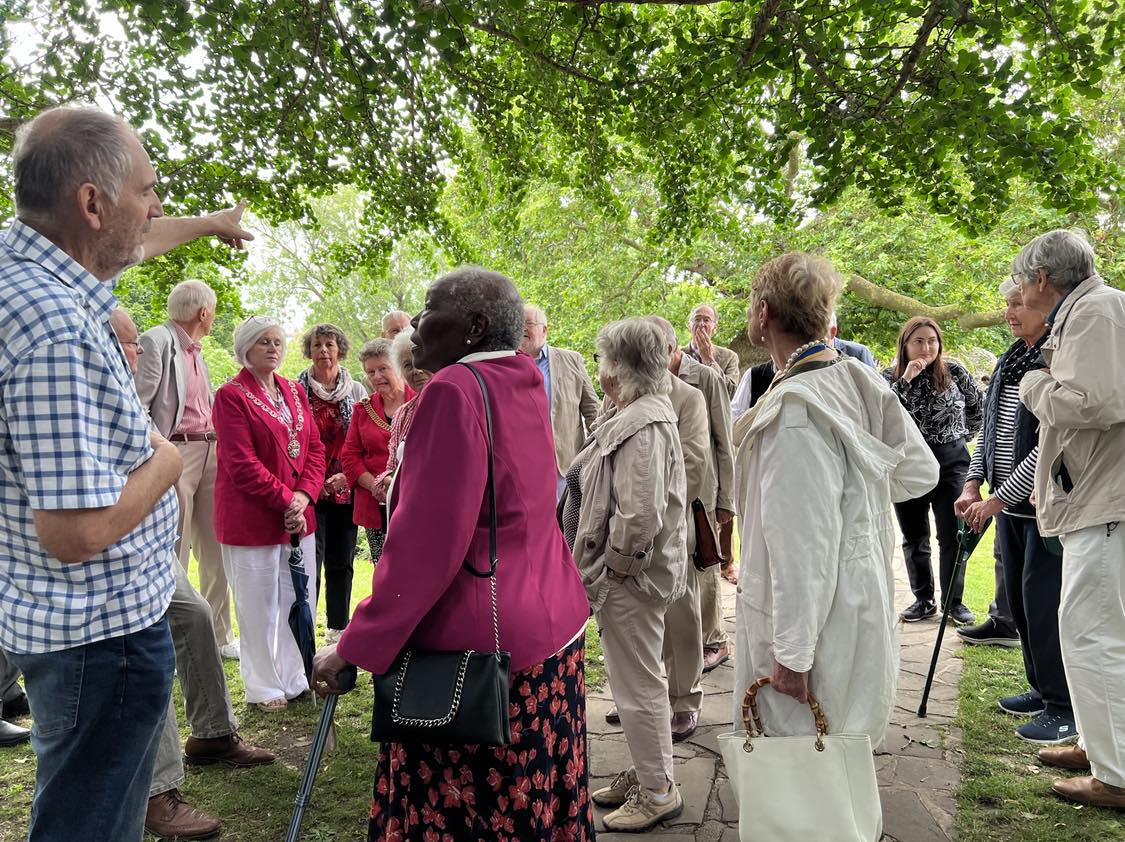
In one of the first more informal events of our new President Rosemary Doyle’s year, a large group of Rotarians and guests met at the Tower House in Canterbury for our little walk through Westgate.
After a brief introduction from Rosemary, Aidan immediately started to tell us about the trees all around us.
First, he drew our attention to the large lime tree just near to where we’d assembled. Aidan told us that these trees (which are unrelated to citrus limes) are important to a number of cultures, and that the wood is often used for wood carvings as it has a very fine grain and tends not to warp. We also learnt that the fibrous bark from the trees, known as “bast”, is used in rope and fabric making in some parts of the world. “Limes are very neglected but very useful,” said Aidan.
Pointing to another nearby tree, Aidan proceeded to tell us about tulip trees – which are unrelated to tulips but so-called because of their tulip-like flowers. Sadly, it was too late in the season to see the flowers, but the seed pods were visible. Apparently such trees, which are common in North America, have been used by Native Americans for canoe making. We were also told that the flowers are packed with nectar – “it’s very good for bees” – and that tulip tree honey can even be bought online. We also learnt that the tulip tree group all originated on the same ancient continent, but geological drift led to them now being found in different parts of the world.
Aidan also pointed out the Chinese variety of the tulip tree nearby – it has similar leaves but its flowers are less obvious. Interestingly, the tree has an inbuilt “insecticide” that makes it resistant to termites. This characteristic means that it’s often used to build log cabins.
Aidan then nipped down to the entrance of the car park and came back with a strange little seedpod of the Turkish hazel. Apparently, just like English hazels, this has nuts inside.
Everyone then wandered over to the so-called “bumpy tree”. This is a tree with a very large girth that most visitors to Westgate Gardens will have noticed. It seems that no-one is totally sure why it’s so bumpy, but the bumps are like burrs and probably arise from some sort of disease or irritation as the tree has grown. “These trees do get very tall, but this one may be stunted by the irritant,” said Aidan. He told us that 99% of trees in parks are forest trees – so naturally they seek more light.
We learned this tree is actually an oriental plane tree, and that such trees are important in both Hindu and Muslim cultures. We also learned that the oriental plane is one of the parents of the London plane (the other being the North American plane, which, confusingly, the Americans call sycamore.) “All of the planes have fantastic timber,” Aidan told us. He added, rather sadly, that “we’ve forgotten the uses of many of our timbers”. This means that such trees are only used as timber if someone happens to have one and cuts it down.
Westgate Gardens’ bumpy tree is well over 100 years old; there are also several others scattered around Canterbury. As some of our members pointed out, these may have been planted in the form of a “crucifix/cross”; this particular one forms part of the Late Queen Elizabeth’s Green Canopy initiative which was in celebration of the Queen’s Platinum Jubilee.
The next trees we looked at were two Ginkgo Biloba trees – also known as silver apricot trees. We learnt that ginkgos are a 60-million-year-old fossil! We looked closely at one leaf – a very distinctive bi-lobed “fan” shape which gives the tree its name – and were told that the Ginkgo is “dioecious”, meaning it has separate sexes. One (to our right) was female, while the other was male. Interestingly, the tree doesn’t have conventional pollen; instead it has “motile sperm”. We also learned about the little biloba “nut”. Apparently there is a huge industry in this in some parts of the world – but there’s a downside. When the seed pods start to decompose they giveoff a very unpleasant smell as if someone has been sick – due to release of the same chemical, butyric acid.
Aidan then pointed out a dawn redwood that was behind us – this is also a living fossil. The dawn redwood is known as a “meta” sequoia as it’s like the famous sequoia that most people will have heard of. This type of tree wasn’t “known” until 1945 or so, and was only introduced to the UK in 1947, meaning the one in Westgate is not as old as one might think. It was probably planted as part of a fad. (One thing that Aidan emphasised during or little tour is the changing fashions in trees: “A lot of trees appear in people’s gardens because of a fashions,” he said). The dawn redwood trees originate from a little tiny place in China, but are now found all over the world. The tree has a brittle, red, light wood so it has no real industrial use – which is probably why there are so few around. Nevertheless, they are often seen around temples.
The next tree that Aidan showed us had lots of pretty pink flowers: it was a chitalpa Turkmenistan, a hybrid of two genuses. This is a drought-resistant tree originally hybridised by a Russian. There are two varieties: one with silvery flowers known as morning cloud, and one with pink flowers known as desert rose. “When this was bought we were looking for something different to replace a number of trees that were taken down,” said Aidan. This year was the first time it had flowered!
We were then alerted to a little “baby” tree behind us – a toona redwood. New shoots of this tree are said to be edible (though please don’t take our word for this). This particular tree is called “toona flamingo” as its new shoots are bright pink. We gather it will be a mass of pink every year.
As we walked to the next tree Aidan said that the beer drinkers amongst us would be amused to know it was called “the brewers droop”; in fact it got its name from a person called Brewer. This tree is another relic from the ice age, and fossils of it can be found in various places. Nowadays, the trees are only found in a few locations; they are under serious threat from climate change as they are adapted to high altitudes. Aidan pointed out how the branches bow down, allowing the trees to cope with heavy snowfall. A lot of these trees, we learnt, have been lost in fires and the seedlings cannot tolerate dryness. The tree only grows a few centimetres each year and has very dense wood. “We value it for its tremendous shape”, said Aidan.
Lastly, we learnt about the walnut tree. Although common in England, the tree originated either in Turkey or the Far East. Although there’s a huge industry in walnut collection in Eastern Europe, China is the biggest producer of the wood which is used to make furniture and guns. The downside of the walnut tree is that it excludes a chemical that suppresses the grown of other plants.
Sadly, we ran out of time so didn’t hear as much as we would have liked to about the chesnut-leaved oak, the sweet amber tree (which has a sweet gum used to sweeten medicines), and the weeping ash (not willow) that are also to be found in the gardens.
At the end of our tree tour we all headed to Tower House, where we enjoyed a picnic supper in the historical building (said to incorporate part of the old city walls). Rosemary thanked Aidan on our behalf and gave him a gift for showing us around. She also thanked the Lord Mayor and Lady Mayoress for joining us. “I will certainly have a different perspective when I walk around the trees,” said the Lord Mayor – reflecting what most of our members were also thinking. Next time you go to Westgate Gardens, do take a closer look at the trees around you!
Picture: Aidan tells our members about the trees in Westgate Gardens. Picture credit: Rotary Club of Canterbury.
For more pictures of the walk visit our Facebook page.


